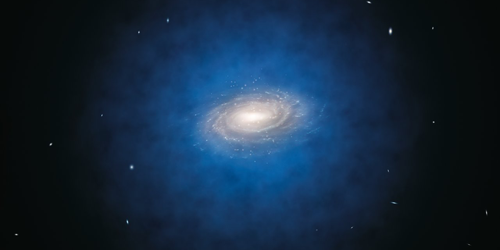A Way to Cool Dark Matter
One widely held belief about dark matter is that it cannot cool off by radiating energy. If it could, then it might bunch together and create compact objects in the same way that baryonic matter forms planets, stars, and galaxies. Observations so far suggest that dark matter doesn’t do that—it resides only in diffuse halos that encompass galaxies. But what if galaxies do contain condensed nuggets of dark matter, and we just haven’t found them yet? Matthew Buckley and Anthony DiFranzo, both of Rutgers University, New Jersey, propose a new model for dark matter that allows it to cool. While their model permits most of the dark matter in a galaxy to form a halo, it also foresees thousands of dark matter substructures sprinkled throughout the galaxy.
The cooling of baryonic matter that led to the formation of cosmic structures was primarily due to interactions between charged particles. If dark matter contains particles that carry something analogous to a charge, perhaps it too could cool. Buckley and DiFranzo create a model where dark matter contains two types of charged particle—the shadowy equivalent of protons and electrons—and show that such particles could radiate energy. Other researchers have pondered dark matter cooling, but those efforts weren’t able to explain why galactic halos don’t collapse. The new model circumvents that problem: Above some critical mass for the dark matter content in a galaxy, cooling is hindered, and dark matter is stuck in a halo. Below that mass, a sufficiently dense blob of dark matter could clump together into a compact object.
The authors do not predict what these objects would be or how astronomers would find them. They speculate that, depending on certain model parameters, these dark denizens could range in mass from supermassive stars to dwarf galaxies.
This research is published in Physical Review Letters.
–Christopher Crockett
Christopher Crockett is a freelance writer based in Montgomery, Alabama.





